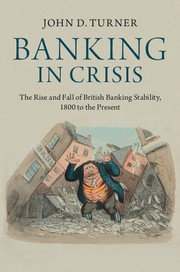Book contents
- Frontmatter
- Contents
- List of figures
- List of tables
- Acknowledgements
- 1 Introduction: Holding shareholders to account
- 2 Banking instability and risk shifting
- 3 The evolution of British banking structure and stability since 1800
- 4 Major and minor British banking crises since 1800
- 5 Banking stability, shareholder liability and bank capital
- 6 Averting or creating banking crises? The lender of last resort and bank rescues
- 7 Banking stability and bank regulation
- 8 Restoring banking stability: Policy and political economy
- Bibliography
- Index
- References
3 - The evolution of British banking structure and stability since 1800
Published online by Cambridge University Press: 05 July 2014
- Frontmatter
- Contents
- List of figures
- List of tables
- Acknowledgements
- 1 Introduction: Holding shareholders to account
- 2 Banking instability and risk shifting
- 3 The evolution of British banking structure and stability since 1800
- 4 Major and minor British banking crises since 1800
- 5 Banking stability, shareholder liability and bank capital
- 6 Averting or creating banking crises? The lender of last resort and bank rescues
- 7 Banking stability and bank regulation
- 8 Restoring banking stability: Policy and political economy
- Bibliography
- Index
- References
Summary
It’s awful – why did nobody see it coming?
Her Majesty Queen Elizabeth IIIntroduction
In this chapter, we measure and assess the stability of the British banking system from 1800 to the present, using a combination of bank-failure data and bank-stock prices. The main finding from this analysis is that there have been two major or systemic banking crises in the past two centuries: 1825–6 and 2007–8. In the interim, there were several minor or nonsystemic crises.
However, before we examine the stability of the banking system, we need to understand how the structure of British banking has evolved since 1800, for at least three reasons. First, we need background and context if we are going to examine the stability of the banking system. Second, the structure of the banking system may have a bearing on its stability and vice versa. Third, the two ways that we have to assess banking stability require us to comprehend the basic evolution of UK banking structure. Thus, the following section describes and explains how the UK banking system evolved. The two subsequent sections explore the stability of the British banking system since 1800 and the effect of banking instability on the real economy.
The development of the British banking system
At the time of the Great Crash of 2007–8, Britain’s banking system was dominated by a small number of banks that had branches not only throughout the United Kingdom but also subsidiaries around the globe. However, two centuries earlier, the United Kingdom had literally hundreds of banks, all of which had a limited geographical reach. How did this transformation happen? To fully understand the evolution of the UK banking system, we must recognize the fact that it evolved from separate systems in England and Wales, Scotland, and Ireland.
- Type
- Chapter
- Information
- Banking in CrisisThe Rise and Fall of British Banking Stability, 1800 to the Present, pp. 35 - 65Publisher: Cambridge University PressPrint publication year: 2014

